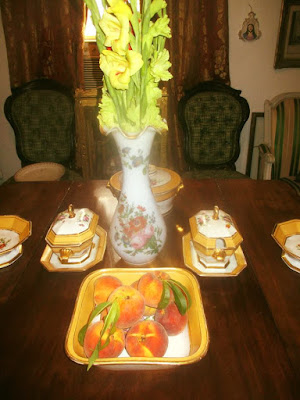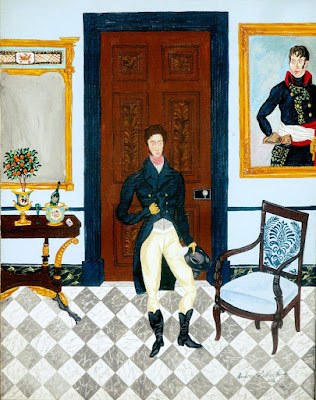There is nothing more delicious than Peach Sangria on a hot sunny day in Creole New Orleans!
Tuesday, July 19, 2016
Saturday, July 16, 2016
Thursday, July 14, 2016
My latest painting, titled "Antoine James de Marigny"
My latest painting is titled "Antoine James de Marigny" 11 x 14 Available.
My latest painting is titled "Antoine James de Marigny". It is apart of a ongoing series of painting of "Creoles in doorways" it depicts the son of famous Bernard de Marigny de Mandeville and Anna Mathilde Morales. Antoine James de Marigny is in his French officer’s uniform. He is standing in his parents lavishly furnished Marigny plantation house at the foot of Elysian Fields Avenue, named after the Champs-Élysées in Paris. The room has gray and white marble floors, The baseboards are painted to look like Egyptian gold vein marble. A eagle Card table by Deming and Bulkley, New York City, ca. 1825. Rosewood.
A Duncan Phyfe & Son Restoration style armchair. A Regency Part-ebonized giltwood octagonal convex mirror circa 1810. And a portrait of Lafayette as a lieutenant general, in 1791.by Joseph-Désiré Court. Antoine James de Marigny was a planter, merchant, military officer, and U.S. Marshal for eastern Louisiana. As a young man, he attended the Academy of St. Cyr and the Royal Cavalry School at Saumur in the 1830s in France, before serving two to three years as a lieutenant in the French Cavalry. In New Orleans, he married Sophronie Louise Claiborne. Daughter of William C. C. Claiborne, the first Governor of Louisiana after statehood. The couple had three or four daughters. 11 x 14 Available.
Wednesday, July 6, 2016
My latest painting titled "New Orleans playboy Bernard de Marigny"
"New Orleans playboy Bernard de Marigny"
My latest painting titled "New Orleans playboy Bernard de Marigny" SOLD 5 minutes after it was finish to the first person I showed it to. It depicts Jean-Bernard Xavier Philippe de Marigny de Mandeville (1785–1868), inside of his family's lavishly furnished Marigny plantation house at the foot of Elysian Fields Avenue, named after the Champs-Élysées in Paris,. He was also known as Bernard de Marigny, He was a French-Creole American nobleman, playboy, planter, politician, duellist, writer, land developer, and president of the Louisiana Senate between 1822 and 1823. In 1798, Louis-Philippe, Duke of Orléans (who became King Louis Philippe in 1830) and his two brothers, the Duke de Montpensier and the Count of Beaujolais, visited the Marigny plantation. By all accounts, they were lavishly entertained by the family. One story recounts that special gold dinner ware was made for the occasion of the Duke of Orleans' visit and was thrown into the river afterward, because no one would be worthy of using it again.
J.D. Ingres' sketch of Lord Grantham in 1816.
The visit of the French royals apparently had a big impact on Marigny, as it is reported as an example of the spoiled life in which he was reared. When he was 15 years old, his father died and Bernard inherited his father's plantation just outside the city gates, east of New Orleans' Vieux Carré. According to historians, "His every whim [was] indulged while his father was alive, he became as wild and headstrong after his death as an unbacked [wild] mustang, and his guardian, abandoning all idea of control, finally shipped him to England, hoping that life abroad might mend his manners; but in London Bernard's dissipations became only more pyrotechnic, and he spent most of his time at Almack's and other famous gambling places." One of the things Marigny brought back to New Orleans from England was the dice game Hazard which became popular in a simplified form, known in local dialect as "Crapaud."
Card Table, Mahogany, ash, birch, cherry, eastern white pine, veneer, paint and gilt ormolu, New York, New York, ca. 1810–25
Classical Empire Old Paris Porcelain Urn
A pair of Old Paris porcelain wine coolers
On reaching his majority in 1806, Marigny at once had his plantation subdivided and began to develop the Faubourg Marigny. (The Louisiana Purchase had taken place in 1803.) Marigny had many gambling debts; and the smaller the land parcels were, the more there were to sell. The area grew rapidly and lots were sold all the way into the 1820s. Marigny's development was immediately popular. He spent most of 1806 and 1807 at the office of notary Narcisse Broutin selling sixty-foot lots or emplacements to prospective home builders. Marigny famously named the streets of his neighborhood whimsically: Abundance, Peace, History, Poets, Piety, Frenchmen, Greatmen, Goodchildren, Music, Desire, Hope, Love, Pleasure, Duels, and Craps (after the game of chance he introduced to America). "Though said to be poorly educated in the classics, he christened the main thoroughfare to his house Elysian Fields after Virgil's "Deathless Residence of the Spirits of the Blessed." Others say that Elysian Fields Avenue was named simply as the English translation for the Parisian Avenue des Champs-Élysées.
Appiani, Andrea (1754-1817) - Portrait of Napoleon Bonaparte as First Consul circa 1800.
As more English-speaking Americans arrived in New Orleans, tensions between them and the settled Creoles began to grow. When two American developers approached Marigny about future commercial development of the city in the area of the Faubourg Marigny, the Creole first agreed, and then reneged by instructing Madame Marigny to stay away from the notary office, thus effectively killing the deal; this was reportedly due to his notorious dislike of the American settlers who were considered uncouth parvenus. This act was seen as extremely bad faith on the part of Marigny, and not only ensured that housing development grew uptown instead of east of the city, but also affected both his finances and his political career: "Marigny was severely blamed by the rest of the Creole population for thus yielding to his anti-American prejudices. This feeling ultimately worked his political destruction. Thereafter he was not looked on as a safe leader, and when he became a candidate for the governorship, they refused to support him."
Regency Verre-Eglomise Mirror. Carved & Gilt Wood and Mirrored Glass with a Verre-Eglomise Panel with Blue Surround and Floral Border Framing a Classical "Military" Trophy or Cartouche. England. Circa 1810.
Strapped for cash, Marigny later sold his lots not only to his fellow Creoles, but to French-speaking gens de couleur of Free people of color, to whom he was also related through his half-sister, the businesswoman Eulalie Mandeville Macarty , thus helping to create a traditional enclave of the New Orleans Creoles of color. Eulalie was the illegitimate daughter of Marigny's father Pierre Philippe, by a black household slave named Marie Jeanne with whom he had a relationship prior to marrying Marigny's mother. Eulalie was given her freedom and brought up by her paternal grandparents who left her well-provided for.
"New Orleans playboy Bernard de Marigny"
Today's Purchases
1830's Louis Philippe Old Paris porcelain.
The last few weeks have been a whirlwind at le château de Hopkins. I got a art show that I had to be prepared for in less than two weeks. I have been trying to stay off of ebay because I know I will always find something to buy. But I found a few good items I just bought today locally from a good friend and Antiques Dealer. Service pieces from a period Louis Philippe Old Paris porcelain dinner service, dating from circa 1830. and a rare 1840's Southern made cut flint glass water pitcher. I love to entertain and can't wait to use these pieces at my next lunch or dinner. It just so happens that today in New York Social Diary is a article about Hyde Hall, built on a hill near Cooperstown, NY, between 1817 and 1833 shows a Old Paris porcelain dinner service in the large and small dining room of Hyde Hall that closely relates to my pieces.
The Hyde Hall Old Paris porcelain is similar to my pieces!
The dining room, located on the other side of the entrance hall, is grand
The family dining room
The family dining room
Pitcher circa 1840 made in West Virginia
MAKER(S)
North Wheeling Flint Glass Works, Sweeney Firm, Manufacturer
This is a example like the one I bought that is in The Corning Museum of Glass - One Museum Way - Corning, NY
Sunday, July 3, 2016
Just finished my latest painting titled "Creole Banquette Blues"
Just finished my latest painting titled "Creole Banquette Blues" The word Banquette is a Creole word for sidewalk. I'm going to let me friend Jelly Roll Morton explain! 9 x 12, available.
Saturday, July 2, 2016
Friday, July 1, 2016
Subscribe to:
Comments (Atom)













































